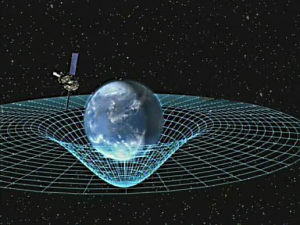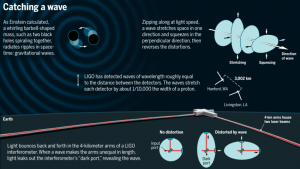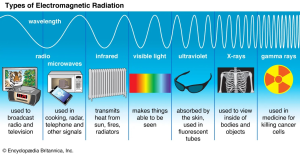Mains – 18th Nov 23
Gravitational Waves
Why in News?
- Recently, scientists said that they have found evidence to suggest that the universe is replete with low-frequency gravitational waves – ripples in the fabric of space-time that are created by huge objects moving around, colliding, and merging with each other, and predicted by Albert Einstein’s General Theory of Relativity more than 100 years ago.
What are Gravitational Waves?
- A gravitational wave is an invisible (yet incredibly fast) ripple in space. Gravitational waves travel at the speed of light (186,000 miles per second). These waves squeeze and stretch anything in their path as they pass by.
- Einstein predicted that something special happens when two bodies—such as planets or stars—orbit each other. He believed that this kind of movement could cause ripples in space. These ripples would spread out like the ripples in a pond when a stone is tossed in. Scientists call these ripples of space gravitational waves.

| Einstein in his General Theory of Relativity showed that massive accelerating objects (things like neutron stars or black holes orbiting each other) would disrupt space-time in such a way that ‘waves’ of undulating space-time would propagate in all directions away from the source. These cosmic ripples would travel at the speed of light, carrying with them information about their origins, as well as clues to the nature of gravity itself. |
What causes gravitational waves?
- The most powerful gravitational waves are created when objects move at very high speeds. Some examples of events that could cause a gravitational wave are:
- when a star explodes asymmetrically (called a supernova)
- when two big stars orbit each other
- when two black holes orbit each other and merge
- But these types of objects that create gravitational waves are far away. And sometimes, these events only cause small, weak gravitational waves. The waves are then very weak by the time they reach Earth. This makes gravitational waves hard to detect.
How do we know that gravitational waves exist?
- In 2015, scientists detected gravitational waves for the very first time. They used a very sensitive instrument called LIGO (Laser Interferometer Gravitational-Wave Observatory). These first gravitational waves happened when two black holes crashed into one another. The collision happened 1.3 billion years ago. But the ripples didn’t make it to Earth until 2015.

Why is the Detection of Gravitational Waves Important?
- The electromagnetic waves (of which visible light is also a part) very often carry information that is characteristic of the objects they are emitted by.
- However, ~95% of the universe is known to consist of dark matter and dark energy, which don’t emit any light or any other electromagnetic waves.
- Hence, most of the cosmos remains ‘invisible’ to astrophysicists and astronomers.
- This changed with the detection of the gravitational waves, which can tell about origin and answer fundamental questions about outer space, such as how different galaxies have emerged and evolved over the entire course of the universe.
How were Low-frequency Gravitational Waves Detected?
- Like a whole spectrum of electromagnetic waves, from microwaves to radio waves, there is a wide range of gravitational waves of different wavelengths, frequencies and energies.
- The gravitational wave that was detected in 2015, and all subsequent detections after that, involved mergers of black holes that were relatively small in size. The gravitational waves produced by them are relatively feeble.
- Only the waves produced just ahead of the merger, when the energy released was maximum, could be detected. These are like flashes of gravitational waves, lasting for maybe a few milliseconds
- In a bid to discover low-frequency gravitational waves, scientists used an entirely different technology.
- The researchers used six large radio telescopes around the world (including the one in Pune) to study objects called pulsars – distant rapidly-rotating neutron stars that emit pulses of radiation, observed from the Earth as bright flashes of light.
- These bursts take place at extremely precise intervals, and therefore scientists use pulsars as ‘cosmic clocks’.
- Some of the signals from these neutron stars arrived a little early while a few others were late, the discrepancies ranging in millionths of seconds.

Artemis Accords
Why in News?
Recently, India signed Artemis Accords.
Recently, India’s Prime Minister announced India’s decision to join the Artemis Accords during the visit to the United States.
- NASA and ISRO will collaborate to send Indian astronauts, trained at the Johnson Space Center in Houston, Texas, to the International Space Station (ISS) in 2024.
About Artemis Accords
- The Artemis Accords are a set of statements that set out common principles, guidelines, and best practices that are applicable to the safe exploration of the moon and eventually beyond as humanity extends the duration of space missions and its reach to Mars – Artemis Programme. The Artemis Program concerns off-Earth exploration and commercial mining of planetary resources and for long term human presence on the Moon and Mars.
- Co-led by NASA and the U.S. Department of State, the Artemis Accords are signed at a national level rather than on an organizational level, and countries that sign the accord do so on a voluntary basis.
- A set of 13 principles, the Artemis Accords is closely linked to the Artemis Program, which aims to return astronauts to the lunar surface, build a space camp there, and carry out deep space exploration.
- The Accords have been signed by 26 countries till now, including Japan, Australia, the UK, France, and Canada.
There was a fair amount of international conversation around it and whether the US law was consistent with Article II of the Outer Space Treaty, which prohibits national appropriation of space resources by claims of sovereignty, by use, by occupation or by any other means.
Following the 2020 Executive Order by the US President (Donald Trump) which stated that the US no longer regarded outer space as a global common, also stated that the US would seek international support and partners for advancing the Artemis Program. That is how the Artemis Accords came about in October 2020.
Why India signed the Artemis Accords?
- The Artemis Accords are a non-binding bilateral arrangement based on the political understanding of the participating countries.
- It is important to note that the Accords document does not specifically refer to commercial exploitation or mining of lunar and asteroid resources.
- The Accords could fast-track India’s human spaceflight capabilities and ambitions, and do so cost-effectively, via collaborations with not just the US but other members of the Accords as well.
- The Accords could finally help catalyse a strong NASA-ISRO collaboration with India’s Chandrayaan 2 lunar orbiter providing advanced orbital data to help plan upcoming robotic and crewed Artemis missions.
Commitments under the Accords:
- Peaceful Purposes: The signatories will implement memorandum of understanding (MOUs) between governments or agencies to conduct space activities for peaceful purposes in accordance with international law.
- Common Infrastructure: Signatories recognize the importance of common exploration infrastructure to enhance scientific discovery and commercial utilization.
- Registration and Data Sharing: Relevant space objects are registered, and scientific data is openly shared in a timely manner. Private sectors are exempt unless acting on behalf of a signatory.
- Preservation of Heritage: Signatories are expected to preserve historic landing sites, artifacts, and evidence of activity on celestial bodies.
- Utilization of Space Resources: Utilization of space resources should support safe and sustainable activities and not interfere with other signatories’ activities. Information on location and nature must be shared to prevent interference.
- Mitigation of Debris: Signatories plan for the safe disposal of spacecraft and limit the generation of harmful debris.
Benefits:
- India’s participation in the Artemis Accords facilitates access to advanced training, technological advancements, and scientific opportunities.
- India can leverage the Artemis programme to advance its own lunar exploration goals, such as the Chandrayan – 3 Mission.
- Collaborating with NASA would enhance India’s capabilities for the Gaganyaan human mission and future ambitious space missions.
- Also, India’s cost-effective missions and innovative approach will benefit the Artemis program, promoting mutual advancements in space exploration.
Challenges:
- The possibility of being seen as aligning with the U.S. against other major space powers, such as China and Russia, who have their own plans for lunar exploration.
- The uncertainty over the legal status and implications of the Artemis Accords, especially regarding the provision that allows for unregulated mining on the moon and other celestial bodies.
- The need to balance its commitments under the Artemis Accords with its obligations under other existing or emerging multilateral frameworks or treaties on outer space.
